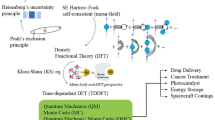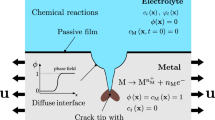Abstract
High electrostatic fields of cations in zeolites and other catalysts is shown to modify the elctronic level struture of molecules. As an example, nitrogen molecules become nitrogen oxide like. It is argued that this is relevant for the Haber–Bosch synthesis. It is also pointed out that fields of the order of volts per Angstrom are equivalent to pressures of GigaPascals.




Similar content being viewed by others
References
Inghram MG, Gomer R (1955) Massenspektrometrische Untersuchungen der Feldemission positiver Ionen. Z Naturforsch Teil A 10:864–872
Block J (1963) Die Feldimpuls-Desorption, eine Methode zur Geschwindigkeitsmessung rascher Chemisorptionsvorgänge. Z Phys Chem NF 39:169–175
Block J (1982) Field desorption and photon-induced field desorption. In: Vanselow R, Howe R (eds) Physics and chemistry at solid surfaces IV. Springer, Berlin
Block JH (1992) In surface science of catalysis. In: Dwyer DJ, Hoffmann FM (eds) In situ probes and reaction kinetics. ACS symposium series 482. American Chemical Society, Washington
Müller EW (1951) Das Feldionenmikroskop. Z Phys 131:136–142
Müller Erwin W, Panitz John A, Brooks McLane S (1968) The atom-probe field ion microscope. Rev Sci Instrum 39:83–86
Miller MK, Cerezo A, Hetherington MG, Smith GDW (1996) Atom probe field ion microscopy. Oxford Science Publications, Oxford
Fink HW (1988) Point source for ions and electrons. Phys Scr 38:260
Ernst N, Drachsel W, Lin Y, Block JH, Kreuzer HJ (1986) Field adsorption of helium on tungsten. Phys Rev Lett 57:2686–2689
Kreuzer HJ, Watanabe K, Wang LC (1990) Theory of field desorption and field ionization: thermal field desorption of helium. Surf Sci 232:379
Tomanek D, Kreuzer HJ, Block JH (1985) Theoretical approaches to field desorption, tight binding calculation of N2 on Fe(111). J Phys 47(C2):139–144
Kreuzer HJ, Wang LC, Lang ND (1992) Self-consistent calculation of atomic adsorption on metals in high electric fields. Phys Rev B 45:12050–12055
Karahka ML, Kreuzer HJ (2016) New physics and chemistry in high electrostatic fields. Surf Sci 643:164–171
Steudel R (ed) (2004) Elemental sulfur and sulfur-rich compounds I (topics in current chemistry). Springer, Berlin
Jaenicke S, Ciszewski A, Dosselmann J, Drachsel W, Block JH, Menzel D (1988) Field-induced structural changes in adsorbed layers of polar molecules studied by photon-stimulated desorption. J Phys 49(C6):191–196
Karahka M, Kreuzer HJ (2011) Water whiskers in high electric fields. Phys Chem Chem Phys 13:11027–11033
Karakha M, Kreuzer HJ, Markus Karahka, Kreuzer HJ (2013) Charge transfer in proton wires. Biointerphases 8:13
Wang LCR, Kreuzer HJ, Nishikawa O (2006) Polythiophene in strong electrostatic fields. Org Electron 7:99–106
Wang RLC, Kreuzer HJ, Grunze M, Pertsin AJ (2000) The effect of electrostatic fields on an oligo (ethylene glycol) molecule: dipole moments, polarizabilities and field dissociation. Phys Chem Chem Phys 2:1721–1727
Kruse N, Abend G, Block JH (1988) The kinetics of adsorption and thermal desorption of NO on stepped Pt single crystal surfaces. J Chem Phys 88:1307–1312
Kreuzer HJ, Wang LC (1990) Field-induced surface chemistry of NO. J Chem Phys 93:6065–6069
Chau T-D, Visart de Bocarné TH, Kruse N, Kreuzer HJ (2003) Formation of neutral and charged gold carbonyls on highly facetted gold nanostructures. J Chem Phys 119:12605–12610
Kreuzer HJ, Gortel ZW (1986) Physisorption kinetics. Springer series in surface sciences, vol 1. Springer, Berlin
Kreuzer HJ to be published
Suchorski Yu, Schmidt WA, Block JH, Kreuzer HJ (1994) Comparative studies on field ionization at surface sites of Rh, Ag, and Au: differences in local electric field enhancement. Vacuum 45:259–262
Isaac T, Bonev Stanimir A (2010) A note on the metallization of compressed liquid hydrogen. J Chem Phys 132:134503–134507
Elatresh Sabri F, Weizhao Cai NW, Hoffmann Ashcroft Roald, Shanti Deemyad, Bonev Stanimir A (2017) Evidence from Fermi surface analysis for the low-temperature structure of lithium. PNAS 21:5389–5394




